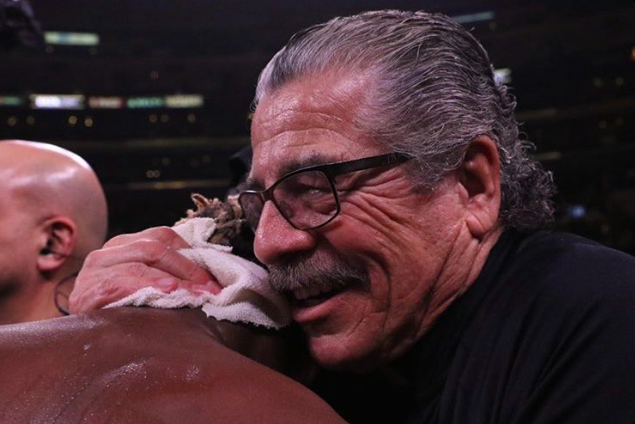Cutmen like Miguel Diaz, Chuck Bodak, and Stitch Duran do much more for their fighters than tend to wounds.
In boxing, it’s a given that fighters face a myriad of dangers, from powerful punches to devastating knockouts. But perhaps one of the most underestimated risks of the sport is the potential for lacerations and bruises to the face. This is where the cutman comes in – a skilled and often unsung hero whose job is to patch up a fighter’s face and keep them in the ring.
At its most basic level, a cutman’s job is to stop the bleeding and minimize the damage caused by cuts and bruises. But the art of cut work is much more than just slapping a piece of gauze on a wound. A good cutman is part artist, part medic, and part psychologist, using a combination of knowledge, skill, and psychological techniques to help their boxers continue fighting.
How a cutman is made
To become a cutman, you need to have a combination of practical experience, medical knowledge, and networking skills. Most cutmen start out as fighters themselves, gaining experience with cuts and swelling firsthand. They then learn about basic medical procedures, such as how to properly sanitize and wrap hands, how to use different types of swabs and cotton pads, and how to identify and treat different types of injuries.
Getting practical experience is key to becoming a successful cutman. Many cutmen start out working with established trainers, fighters, or other cutmen, assisting them during matches and learning from their experience. Others may volunteer at amateur fights or work as assistant trainers to gain experience and build their reputation.
Once you have gained enough experience and knowledge, you can seek out certification from organizations such as the Association of Boxing Commissions (ABC) or the World Boxing Council (WBC). These certifications can help you gain recognition as a qualified cutman and increase your chances of getting hired for professional fights.
Legends of the corner
One of the most legendary cutmen in boxing history is Chuck Bodak, who worked with Muhammad Ali, Sugar Ray Leonard, and many other boxing greats. Bodak was known for his skills in treating cuts and swelling, but he also had a uniquely psychological approach to his work. He would often use humor and storytelling to distract fighters from the pain of their injuries, helping them to stay focused and motivated.
Another famous cutman is Miguel Diaz, who has worked with Manny Pacquiao, Julio Cesar Chavez, and other top fighters. Diaz is known for his meticulous attention to detail and his ability to quickly and effectively treat even the most severe injuries. He has also written several books on cut work and sports medicine, sharing his knowledge with aspiring cutmen around the world. Look for his name on one of our reading lists soon.
I’d be remiss if I didn’t mention one of the most well-known cutmen in boxing today: Jacob “Stitch” Duran, who has worked with some of the biggest names in the sport, including Georges St-Pierre, Wladimir Klitschko, and Conor McGregor. Duran is known for his trademark fedora, often worn in his younger years, and his calm demeanor in the face of even the most severe injuries. He is also a successful businessman, running his own line of sports apparel and training gear.

Perhaps the most intriguing aspect of cutmen, though, is the bond they share with their fighters. In many ways, the cutman is the unsung hero of the boxing world, quietly patching up fighters and helping them stay in the ring another round. The relationship between a cutman and their fighter goes deeper than just a professional one, and the emotional support they provide is arguably just as crucial as the medical care.
In fact, some cutmen have even saved the lives of their fighters. In 2015, cutman Mike Bazzel helped to save the life of boxer Prichard Colon, who had suffered a serious brain injury during a fight. Bazzel noticed that Colon was in distress and quickly called for medical help, potentially saving the young fighter’s life.
Considering a career as a cutman? Communication is key
Another important aspect of the cutman’s job is communication. Cutmen need to be able to communicate effectively with fighters, trainers, referees, and medical staff in order to provide the best possible care. They need to be able to quickly assess a situation and make decisions on the spot, often under intense pressure.
Despite the challenges of the job, many cutmen find it incredibly rewarding. They take pride in their ability to help fighters continue to compete, even in the face of serious injuries. It’s also pretty cool to get to work with some of the biggest names in the sport, knowing that their work is helping shape the future of boxing.
In recent years, the use of new technologies, such as instant replay and concussion sensors, has made it easier for cutmen to identify potential injuries and take action quickly. Still, even with all of these advances, the role of the cutman remains crucial to the success of any fighter. The boxing world will always need their expertise, wisdom, and support.
Could a career as a cutman be right for you?
